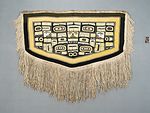Chilkat Robe
About this object
History of use
Weaving blankets from mountain goat wool mixed with shredded cedar bark is an ancient and complex tradition. The techniques were kept alive by the Tlingit, who acquired weaving knowledge through marriage with the Tsimshian. The robes were traded along the coast to be worn on ceremonial occasions by Haida, Tsimshian and Kwakwaka'wakw chiefs. Chilkat robes were symbols of wealth: to own them endowed a chief with prestige. Even greater prestige resulted from giving them away in potlatch. If there was no chief attending of high enough rank to receive it, the blanket might be cut into strips and distributed to a number of persons of prestige. These strips would be made into other ceremonial garments, such as shirts, aprons, leggings, headdresses, or bags. In recent years, weavers from other coastal communities have relearned the techniques, using sheep’s wool with cedar, to produce modern versions for ceremonial use.
Narrative
The Nisga’a leader Txaalaxhatkw (c. 1848–c. 1939), of the Eagle Clan of Gitlaxt'aamiks, was the owner of this robe and leggings (A7078 a-b). He is said to have offered the set to Rev. W.H. Collison in 1890 even though he had refused to sell them previously to Marius Barbeau. These leggings were cut from other chilkat blankets, likely as part of a potlatch ceremony. According to the Reverend’s son, W. E. Collison, Txaalaxhatkw was "the last of the Nass [River] chiefs to accept Christianity." Known also as Gitiks and by his English name, Frank Bolton, Txaalaxhatkw recorded Nisga'a songs on wax cylinders with ethnologist Marius Barbeau in the 1920s. Now accessible once again to the Nisga’a community through digitized versions, the songs may include ones associated with regalia like this, representing the histories and intangible wealth that are embodied here in woven form.
Cultural context
ceremonial
Iconographic meaning
Three panel distributive design. In the centre is an ancestor face surrounded by a whale, frog and bird motif. The side panels have ancestor faces in profile. Emblems or crests distinguish different social groups (lineages, phratries, or moieties) and symbolize their privileges. They can be shown on any material possessions, such as totem poles or robes, and each group owns the right to display specific crests. Within each group, families or individuals have the right to show the general crests is specific ways.
Specific techniques
Traditionally, the design was first painted onto a pattern board by a man, then precisely copied in weaving by a woman. The style operated within strict conventions, but at the same time permitting subtle individual variations and originality. The weaving technique evolved from the craft of finger twining yellow cedar bark blankets. Bark continued to form the core of the warp strands in the blankets which were handspun with mountain-goat wool. The handspun woolen weft may be left off-white, or dyed with hemlock bark for black, wolf moss for yellow, adding blue from copper or trade blankets to achieve a blue-green for different areas of the design. The loom is a single beam loom which consists of two upright posts, and a broad crossbeam from which the warp hangs freely. The warp ends are divided into sections and inserted into gut bags to keep the warps clean and untangled during twining. Weaving proceeds from top to bottom of the blanket, and extra warps are added when the design field is completed, in order to produce the curved border at the bottom. (In Tsimshian, this type of robe is called gwiis halayt.)
Physical description
Chilkat style robe with woven designs and fringe. The design is yellow, blue and black on natural ground. There is a long twisted fringe on three sides of mixed wool and cedar bark. The top edge is lined with otter fur and has two blue fabric ties for securing the robe around the neck.
Categories
Materials
Mountain goat wool fibre Cotton fibre Linen fibre Jute fibre Hemlock bark dye? Wolf moss dye? Dye Cedar bark Otter skin
Subjects
